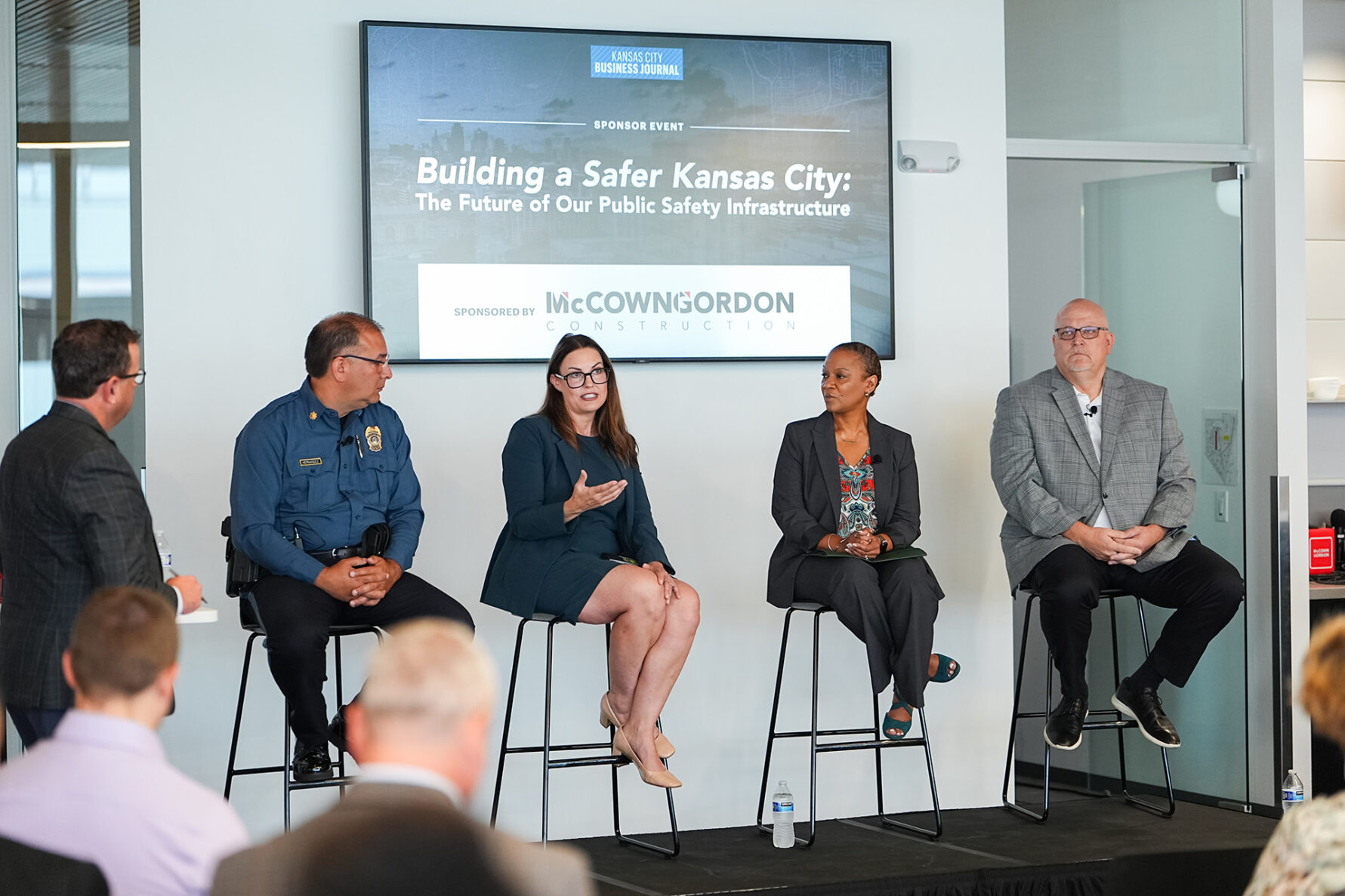Transforming Public Safety in the Kansas City Metro
Insights from a Kansas City Business Journal Panel

Public safety in the Kansas City metropolitan area is undergoing a dynamic transformation, driven by evolving community needs, increased awareness of mental health, and a forward-looking vision. Recently, leaders from across the metro gathered at McCownGordon Construction for the ”Building a Safer Kansas City ” panel discussion where they shared innovative strategies for addressing public safety challenges. Below are key takeaways from the conversation that examine how these efforts are shaping a safer, more connected community.
Public Safety in the Kansas City Metro
Over the past two decades, the concept of public safety in the metro has evolved significantly. Panelists agreed that today’s approach is far more holistic, extending beyond the traditional roles of police and fire departments now encompassing everything that contributes to a sense of security within one’s community. Lori Curtis-Luther, city manager of Overland Park, emphasized how elements that provide open sightlines in public settings like adequate lighting and tree and brush maintenance can influence how safe people feel—sometimes more than the presence of a patrol car. Major Timothy Hernandez of the Kansas City Police Department (KCPD) echoed this sentiment, noting that public safety has become a collaborative effort driven by community input. He highlighted how policing has evolved not just locally or nationally, but globally.
Community outreach and collaboration with area residents are central to improving public safety across the metro. Kansas City, Mo., has a dedicated community engagement team that works directly with urban neighborhoods to better understand residents’ needs. Deputy city manager, Kimiko Gilmore, explained, “The City of Kansas City always takes a listening approach, however, historically, neighborhoods have been told what they need instead of being listened to. There’s a lot of trust we need to rebuild in those neighborhoods and communities.” She added, “It’s not just about providing basic services to our community. It’s about hearing, looking, and seeing exactly what is happening, so we can communicate that to our departments and work collaboratively to get the resources where they need to go.”
Public safety in Kanas City is no longer just reactive, it’s increasingly proactive. KCPD has implemented a three-tiered system that uses data to identify where crime is occurring and deploy resources accordingly. This includes community engagement through social workers, mental health and substance abuse support, outreach to veterans, and partnerships with schools. Major Hernandez also described a crime reduction strategy called “Focus Deterrence,” which targets high-risk offenders responsible for the most violent crimes. The department works to connect these individuals with tailored social services that provide support and opportunities to not only change behavior but change their life trajectories.
The Impact of Mental Health
One of the most significant shifts metropolitan leaders have observed over the past decade is the growing emphasis on mental health, not just for community members, but also for emergency response personnel. “A lot of people don’t think about putting themselves in the shoes of police officers who have to make a life-or-death call in a response situation,” said Todd Pelham, deputy city manager for the City of Lenexa.
Cities across the metro are working to address the mental health crisis by integrating co-responders into emergency calls, providing specialized support where traditional police responses may not be appropriate. “We could use co-responders on virtually every call,” said Curtis-Luther. However, limited resources make this difficult to implement. In many cases, emergency responders arrive at scenes involving individuals with mental health diagnoses who require care beyond the scope of standard police or fire services. “We’re actively trying to thread the needle—getting the right resources to the right places at the right time to prevent escalation and ensure everyone gets home safely,” Curtis-Luther added.
Across the state-line, Major Hernandez spoke to the toll that emergency responses take on officers, particularly in high-stress or traumatic situations. He defined these as “critical incidents” which are events that leave lasting mental impressions. “The average citizen may experience seven to 10 critical incidents in their lifetime; the average police officer sees between 750 and 1,000,” he said.
To support officer wellness, KCPD has implemented a process to ensure responders receive care after such incidents. “After critical situations, we make sure officers get the resources they need,” Major Hernandez explained. “Our wellness unit checks in with them, evaluates whether they should be sent home for the day, and ensures someone is at home to support them. Our officers are assets to the community, and we do everything we can to take care of them and make sure they’re equipped to fulfill their duty to serve and protect.”
A Focus on Recruitment & Leadership
Panelists discussed innovative strategies for recruiting public safety professionals and emphasized the critical role of leadership in shaping successful teams. One standout initiative, shared by Pelham, is the launch of the city’s college internship program. This program not only introduces young professionals to career paths in public safety but also immerses them in the organizational culture and daily responsibilities, which can lead to a more informed, engaged and committed career decision.
Kansas City is also taking proactive steps to recruit and retain top-tier public safety talent. “Our number one recruiter is the community, and we want to have support from the community in our recruitment efforts,” said Major Hernandez. He emphasized that community members are often the best advocates for identifying future public safety professionals. Gilmore added that they are working to build awareness of public safety careers early, beginning in elementary school, as part of a long-term strategy to strengthen the workforce.
“You must have the right people in the right job at the right time,” said Curtis-Luther. She and Gilmore both stressed that effective leadership can significantly improve staffing levels and morale, even when resources are limited. Strong leadership also fosters regional partnerships, which are essential for tackling large-scale initiatives like the upcoming 2026 FIFA World Cup. “You can have all manners of resource limitations, but if you have a good, positive, firm, strong leader, your people will follow you into the fire,” said Gilmore. “When we take the time to vet our leadership, then we can get the impacts and outcomes that we need.”
Educating the Public
Municipalities across the Kansas City area are taking meaningful steps to strengthen their connection with residents through innovative and inclusive initiatives. The KCPD is opening its local campuses to serve as community hubs, offering public access to its gyms, computer labs, and event spaces. These facilities host everything from basketball games to neighborhood meetings, fostering a sense of shared space. Major Hernandez emphasized that opening patrol stations to the public has been instrumental in building trust and encouraging positive interactions between law enforcement and the community.
In Lenexa, the city is investing in education and technology to deepen public understanding of police work. Pelham shared that Lenexa hosts annual classes at their police station to explain how use-of-force data is tracked and interpreted, helping to demystify law enforcement practices and terminology. They also explore the physiological stress officers face in high-stakes situations. Cutting-edge virtual reality technology allows participants to step into simulated scenarios, sparking tough but necessary conversations about decision-making and response.
Lenexa also runs programs like “Work Out with a Cop,” which break down barriers by giving residents the chance to connect with officers in a relaxed, informal setting. These interactions offer insight into the daily experiences and training of public safety professionals, while reinforcing transparency and relationship-building.
How Kansas City Leaders are Preparing for the World Cup
Kansas City was selected as one of the host cities for the 2026 FIFA World Cup, and local leaders are already deep into strategic planning to ensure the region is ready for the global spotlight. Panelists expressed both excitement and a clear understanding of the logistical challenges ahead. Each panelist emphasized the enthusiastic support from the local business community and the importance of allocating limited public resources wisely.
While Kansas City will be at the center of the action, surrounding municipalities must also prepare for the estimated 650,000 visitors expected to descend on the region. In Lenexa, Pelham shared how city leaders are planning for key logistical needs, including traffic control barriers, temporary housing policies for short-term rentals, and flexible, relationship-driven strategies to manage unexpected challenges.
Addressing concerns about Kansas City’s readiness, Gilmore reassured attendees that the city is actively working on safety and security measures. “Despite the rumors, we will be fully prepared,” she said. Gilmore reminded the audience that Kansas City has successfully hosted major events in the past, including championship parades, the NFL Draft, and All-Star games, and is more than capable of rising to the occasion once again.
Today, public safety is more than policies and procedures; it’s about how people feel in their communities. As Major Hernandez put it, “Everyone wants the same thing. They want to be safe, they want their family and loved ones to be safe, and they want to go home at the end of each night and not be the victim of a crime.” The panel discussion reinforced that safety is a shared priority, rooted in trust, connection, and the desire for peace of mind.



